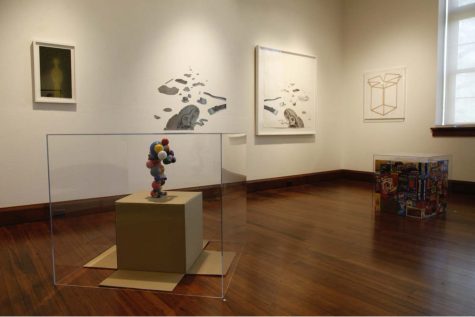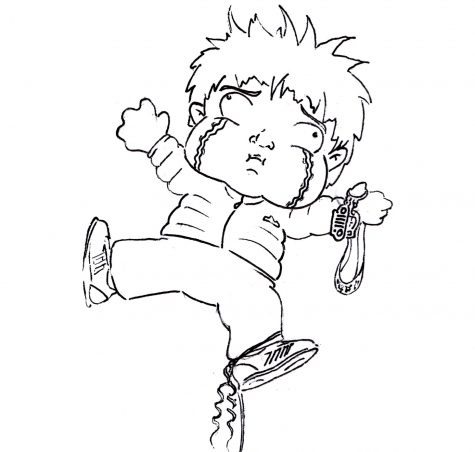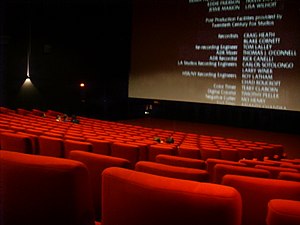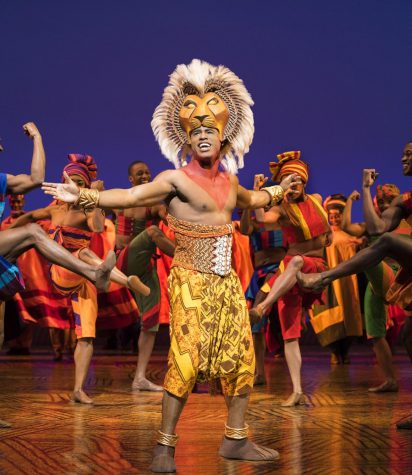Faculty Art Show Review
October 16, 2018
The 2018 Faculty Art Show, displayed in the Bonsack Gallery from August 24th to October 12th, exhibits the work of Burroughs’ Art Department Faculty. Here are The World art critic Adina Cazacu-De Luca’s thoughts on a few pieces by each artist.
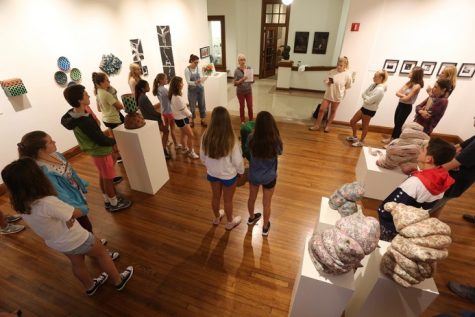
Andrew Newman
What’s better than admiring natural beauty in its raw form without the pressure of imposing greater meaning on it? According to Andrew Newman ’87 (and myself), not much. Seeing clouds as “symbols of impermanence,” Newman believes they are most beautiful when they “free themselves of subject matter and literal interpretation and fall completely in the realm of abstract,” citing Alfred Stieglitz’s “Equivalents” series as a source of inspiration. Like Stieglitz, Newman chose to make his cloud series black-and-white. This might seem like a missed opportunity, as Newman himself recognizes the “special role of color” in clouds early morning or around sunset. However, the small black and white photographs are breathtaking. The contrast and texture of the clouds floating above different mountains are enough to take in in grayscale, especially when the softness of the clouds plays with rougher textures of pine trees and rigid snow-capped mountains. Each cloud of the series has its own personality: small but full, whimsical, majestic and ponderous. Newman says that he hopes to continue this series while on sabbatical next year, perhaps in forest park or some distant land on his travel itinerary.
Donya Allison
I found myself partial to Donya Allison’s photographs, which are inspired by the Dutch Masters. Allison’s artist statement explains that the work, “while…meant to appear sensual and beautiful, also reference[s] the ephemeral nature of life and contain[s] clues surrounding issues of consumerism and consumption.” Honestly, these photos made me chuckle. The beautiful contrast and dynamic between black background, white fragility and strong silver with small ornamentation in “Lilium Longiflorum,” is complemented with a dead chick lying with its feet glued in the air. The Dutch Masters, to the best of my knowledge, played with one idea at a time. Either you had a still life of fruit and flowers or a still life of rabbits hanging in a butcher shop. Either life or death was preserved in the moment of the artist’s choosing; Allison’s mixing of the two reminds us we can’t have life without death; each concept is defined by the other.
The other three photographs bring a modern take on still life. Takeout boxes, plastic produce bags, and produce stickers are all present next to more typical still life participants: beets, silk drapes and other greenery. These details are subtle, but once you notice them, they’re the only aspect of the photograph you see each time you look back on it. Perhaps we will one day look back on our current consumerist tendencies at the expense of the environment and view the subtle details in the same impactful way.
Jessica Hunt
In her artist statement, Jessica Hunt aims to explore “the interpersonal relationships we create” and “our desire to be vulnerable particularly within the home.” Hunt’s four Digital Prints accomplish this goal. Each print encapsulates the relationships between loved ones. “The Protector” pictures a father and son, wearing matching plain outfits (white t-shirts, grey sweatpants, black slides) in a plain setting. A single grey chair is in the corner of a grey room with pale hardwood floors. Yet this image, which would otherwise be cold, is made warm by these bulbous masks that both the father and son are wearing. They vaguely resemble a shrimp made of pink insulation. The masks present in all four prints give the work its desired sense of “conscious ambiguity,” where the viewer can become a part of the work. Personally, the first image that came to my mind was Magritte’s “Lovers” (1928), where two figures are kissing each other, each with a white cloth over their heads. However, Hunt developed her work independently without thought of Magritte, and the two works carry separate meanings. While the masks in Hunt’s work create ambiguity, they are also personalized. Each relationship’s mask is unique, just as each relationship is unique and has a distinct intimacy. The masks serve to unify, while Magritte’s seem to keep the lovers separated. The second print of four, “The Newlywed Snug,” features a couple in all-white loungewear with their legs intertwined to the point they are indiscernible. The setting has far more detail than “The Protector’s,” yet the focus remains solely on the couple. Last note on the digital prints: the models in “Late Night Kitchen Vibes” are actually Hunt and her partner. While in the other three prints, the people in the pairs have similar masks to each other, the two in “LNKV” seem unrelated. And while the other couples are embracing, the only physical contact in “LNKV” is a hand on a shoulder. Again, each situation is completely unique because each relationship defines intimacy in a unique way.
Ashley Edgerton Oates
Maybe I’m a traditionalist critic when it comes to art. Maybe. Ashley Edgerton Oates’ artist statement outlines that her work conveys “the duality of absence and presence-echoing the often-slippery relationship between strength and fragility; truth and fiction; protection and vulnerability.” Now, I tried to envision those dualities in Oates’ photogenic and charcoal drawings. I struggled. To be fair, “Foxholes to Burrows and Back” is a cool piece. The “tunnel system” comprised of different wires and industrial materials over multiple sheets had a surprisingly organic quality, and the varying brightness and contrast of each sheet gave the work depth. I can accept the idea that absence of subject matter equates to absence as a motif in the work. However, the extrapolation towards other juxtapositions leaves me slightly unsettled with the piece. I keep looking for more.
Mike Gesiakowski
Honestly, fine arts teacher and department chair, Mike Gesiakowski’s artist statement has robbed me of most of my analytical comments. He hopes to reveal “the correlations between architecture and our recollections, the being the slow erosion of both over long periods of time.”Additionally, the transformation of 3-D architecture into 2-D art represents “the transformative aspects of our experiences from real-world existence to the stored information in our minds.” The shiny, glazed surfaces of Gesiakowski’s plates “offer a contradiction to this state of decline, as memories are altered and embellished through imprecise remembrance.” However, I’m by no means critiquing Gesiakowski for outlining his thought process for his audience. Ceramics is a difficult medium to convey greater meaning given its decorative history. When a person examines a glazed plate, they might comment on its beauty, but usually, they won’t mention how it questions the construct of architecture and human’s sense of place. If anything, an explanation of intent is a key that unlocks a new view of the work.
Specifically, regarding Gesiakowski’s set of four plates, the layering of multiple patterns stuck out to me. Some patterns are faded to the point they’re almost unnoticeable, while each stencil of the top-most layer has its bottom half smudged and dragged down. The pattern, like memory, doesn’t disappear but is degraded to a state that the original pattern would be unrecognizable given only the smudged bottom half. In Vestige, the contrast between matte terracotta, bright light green and dark blue glaze ties together what was established as cognitive degradation with physical deterioration and the concept of architecture. Gesiakowski says he began developing the technique in the show’s work when he was in grad school, but just now feels comfortable. He says there were “lots of tests, lots of failures” in his 6-year creative process. “But they’re great for understanding that you’ll never get it right the first time. You’ll learn more from failure than if you succeeded straight away.” Gesiakowski wants to remind JBS students that failure is not only acceptable but necessary to the learning process.



